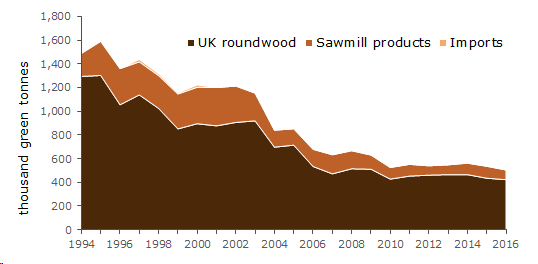We use some essential cookies to make this website work.
We’d like to set additional cookies to understand how you use forestresearch.gov.uk, remember your settings and improve our services.
We also use cookies set by other sites to help us deliver content from their services.
The integrated pulp & paper mills in the UK consumed a total of 0.5 million tonnes of material (all softwood) in 2016, a 6% decrease from the 2015 total (Table 2.20).
UK roundwood represented 84% of the inputs for the integrated pulp & paper mills in 2016, with the remaining 16% coming from sawmill products.
Table 2.20 Inputs for the integrated pulp & paper mills1, 2007-2016
| Year | UK roundwood2 | Sawmill products | Total |
| thousand green tonnes | |||
| 2007 | 472 | 161 | 633 |
| 2008 | 515 | 152 | 667 |
| 2009 | 511 | 120 | 631 |
| 2010 | 428 | 98 | 526 |
| 2011 | 453 | 99 | 552 |
| 2012 | 461 | 79 | 540 |
| 2013 | 465 | 83 | 548 |
| 2014 | 465 | 97 | 562 |
| 2015 | 435 | 101 | 536 |
| 2016 | 423 | 82 | 505 |
Source: UK Forest Products Association
Notes:
1. Excludes inputs of recycled paper and cardboard. All inputs are softwood.
2. UK roundwood derived from stemwood.
Figure 2.3 Inputs to integrated pulp and paper mills

Source: UK Forest Products Association
Cookies are files saved on your phone, tablet or computer when you visit a website.
We use cookies to store information about how you use the dwi.gov.uk website, such as the pages you visit.
Find out more about cookies on forestresearch.gov.uk
We use 3 types of cookie. You can choose which cookies you're happy for us to use.
These essential cookies do things like remember your progress through a form. They always need to be on.
We use Google Analytics to measure how you use the website so we can improve it based on user needs. Google Analytics sets cookies that store anonymised information about: how you got to the site the pages you visit on forestresearch.gov.uk and how long you spend on each page what you click on while you're visiting the site
Some forestresearch.gov.uk pages may contain content from other sites, like YouTube or Flickr, which may set their own cookies. These sites are sometimes called ‘third party’ services. This tells us how many people are seeing the content and whether it’s useful.